Heart failure: preventing disease and death worldwide
World Heart Failure Alliance: Global Heart Failure Awareness Programme
The Global Heart Failure Awareness Programme is supported by Novartis Pharma AG and SERVIER, in the form of an unrestricted educational grant.
Abstract
Heart failure is a life-threatening disease and addressing it should be considered a global health priority. At present, approximately 26 million people worldwide are living with heart failure. The outlook for such patients is poor, with survival rates worse than those for bowel, breast or prostate cancer. Furthermore, heart failure places great stresses on patients, caregivers and healthcare systems. Demands on healthcare services, in particular, are predicted to increase dramatically over the next decade as patient numbers rise owing to ageing populations, detrimental lifestyle changes and improved survival of those who go on to develop heart failure as the final stage of another disease. It is time to ease the strain on healthcare systems through clear policy initiatives that prioritize heart failure prevention and champion equity of care for all.
Despite the burdens that heart failure imposes on society, awareness of the disease is poor. As a result, many premature deaths occur. This is in spite of the fact that most types of heart failure are preventable and that a healthy lifestyle can reduce risk. Even after heart failure has developed, premature deaths could be prevented if people were taught to recognize the symptoms and seek immediate medical attention. Public awareness campaigns focusing on these messages have great potential to improve outcomes for patients with heart failure and ultimately to save lives.
Compliance with clinical practice guidelines is also associated with improved outcomes for patients with heart failure. However, in many countries, there is considerable variation in how closely physicians follow guideline recommendations. To promote equity of care, improvements should be encouraged through the use of hospital performance measures and incentives appropriate to the locality. To this end, policies should promote the research required to establish an evidence base for performance measures that reflect improved outcomes for patients.
Continuing research is essential if we are to address unmet needs in caring for patients with heart failure. New therapies are required for patients with types of heart failure for which current treatments relieve symptoms but do not address the disease. More affordable therapies are desperately needed in the economically developing world. International collaborative research focusing on the causes and treatment of heart failure worldwide has the potential to benefit tens of millions of people.
Change at the policy level has the power to drive improvements in prevention and care that will save lives. It is time to make a difference across the globe by confronting the problem of heart failure.
A call to action: policy recommendations
We urge policymakers at local, national and international levels to collaborate and act on the following recommendations.
Promote heart failure prevention
- Support the development and implementation of public awareness programmes about heart failure. These should define heart failure in simple and accessible language, explain how to recognize the symptoms and emphasize that most types of heart failure are preventable.
- Highlight the need for healthcare professionals across all clinical disciplines to identify patients with illnesses that increase the risk of heart failure and to prescribe preventive medications.
- Prioritize the elimination of infectious diseases in parts of the world where they still cause heart failure.
Improve heart failure awareness amongst healthcare professionals
- Encourage the development and use of heart failure education programmes for all appropriate healthcare professionals. These should aim to improve the prevention, diagnosis, treatment and long-term management of heart failure and raise awareness of clinical practice guidelines.
Ensure equity of care for all patients with heart failure
- Provide a healthcare system that delivers timely access to diagnostic services and treatment of heart failure, as well as a seamless transition to long-term management.
- Ensure that the best available and most appropriate care is consistently provided to all patients with heart failure through efficient use of resources.
Support and empower patients and their caregivers
- Provide resources for the education and practical support of patients with heart failure and their families or other caregivers, empowering them to engage proactively in long-term care.
Promote heart failure research
- Fund and encourage international collaborative research to improve understanding of the patterns, causes and effects of modern day heart failure and how the disease can be prevented across the globe.
- Fund and encourage research into new and more affordable therapies and medical devices for all types of heart failure.
- Fund and encourage research into evidence-based healthcare performance measures that reflect improved clinical outcomes for patients with heart failure.
Introduction
The prevention of disease and death due to heart failure needs to be made a global health priority. Despite the increasingly large numbers of people living with and dying from heart failure, awareness of the disease is low amongst the public, politicians and even some healthcare professionals. Although there is no cure for heart failure, many cases are preventable, and most patients can be treated effectively to improve quality of life and survival. Policymakers have a responsibility to ensure that as many people as possible benefit from the available measures for prevention, diagnosis, treatment and long-term management of heart failure. At the same time, research should be supported in areas in which there are urgent unmet needs.
An international approach is needed to identify the most effective ways of addressing the problem of heart failure in different parts of the world and to incorporate the necessary measures into everyday practice. To this end, the Heart Failure Association of the European Society of Cardiology has launched the Global Heart Failure Awareness Programme. Heart failure groups across the globe will be involved in the programme to ensure sharing of knowledge, experience and recommendations across countries and continents.
This white paper is a core component of the inaugural phase of the Global Awareness Programme. It examines the worldwide burden of heart failure, highlights the challenges of dealing with the disease and makes evidence-based recommendations for policy change (Figure 1). Policy initiatives at local, national and international levels have the potential to reduce deaths due to heart failure and improve quality of life for patients.
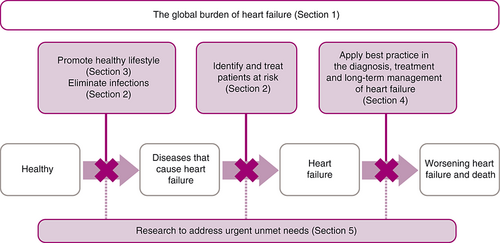
The global burden of heart failure
Patient perspective2
When you have heart problems, you always worry [that] the next breath is your last one. That's something you never know.
Heart failure survival rates remain poor across the globe
Across the globe, 17–45% of patients admitted to a hospital with heart failure die within 1 year of admission and the majority die within 5 years of admission (Figure 2).3-24
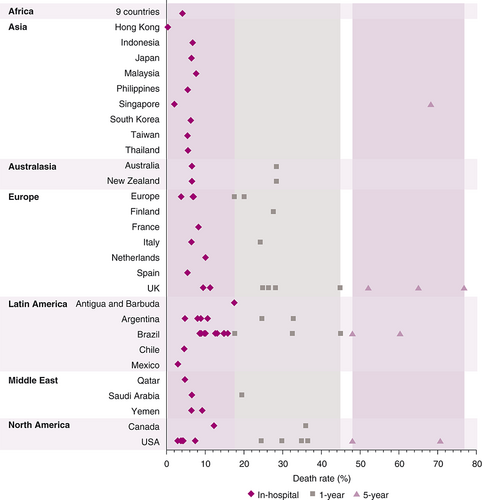
In recent years, survival rates for patients with heart failure have improved in many parts of the world, in parallel with the introduction of modern evidence-based therapies and patient management systems.3, 25-31 Nevertheless, about 2–17% of individuals admitted to a hospital with heart failure die while in a hospital (Figure 2). Survival rates are better for those treated in outpatient clinics, who typically have less severe symptoms than those treated in a hospital.22, 32 However, even the latest therapies may only relieve symptoms in many patients, without slowing the progression of their disease or prolonging life.33, 34 This is because heart failure can arise from a number of different underlying problems with the structure or function of the heart, some of which are more difficult to treat than others (see Section on Preventing Heart Failure in High-risk Groups).
Despite improvements in care over the past 20 years, the outlook for patients with heart failure remains poor, and survival rates are worse than those for bowel, breast or prostate cancer.35-37
Heart failure is common, and patient numbers are increasing
About 26 million adults worldwide are living with heart failure,38 leading some to describe it as a global pandemic.39 In comparison, 32 million are living with cancer40 and 34 million with HIV/AIDS.41 In many countries, population-based studies have found that about 1–2% of people have heart failure, and similar or higher proportions have been reported in single-centre studies (Figure 3).4, 8, 9, 11, 42-46
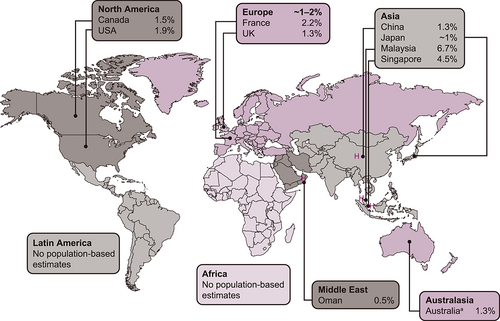
Heart failure becomes more common with increasing age. In North America and Europe, few patients with heart failure are 50 years of age or younger50-52 and more than 80% are 65 years of age or older.38 The number of patients with heart failure is predicted to increase in countries with ageing populations.53 Japan, in particular, has the most rapidly ageing population of all economically developed nations.54 In the USA, there were 5.8 million patients living with heart failure in 2012, and this is expected to rise to 8.5 million by 2030.45 Another contributing factor to these increasing numbers is the improvement in treating heart attacks and other cardiovascular diseases that damage or place an extra burden on the heart. More patients with these conditions are surviving now than did in the past, but those who survive are at high risk of going on to develop heart failure.39
In economically developing areas, such as parts of Latin America and Asia, the numbers of patients with heart failure are also increasing.55-58 The increase is largely a result of the shift towards a Western-type lifestyle and its associated diseases, for example, conditions such as diabetes increase the risk of developing heart failure (see Section on Preventing Heart Failure in High-risk Groups). This is despite reductions in the number of cases caused by Chagas disease in urban areas of Latin America58 and reductions in the number of cases of Davies disease (a disorder in which the heart muscle becomes rigid) in tropical areas.59
Infections remain a common cause of heart failure in many parts of the world and can strike at any age. Heart failure is not a disease of the elderly in sub-Saharan Africa, where half of patients hospitalized with the disease are 55 years of age or younger.5 Patients in the Asia Pacific region also tend to be younger than those in Western regions.60 Rheumatic fever due to preventable bacterial infections is a prominent cause of heart failure in Africa, Asia, Australasia and Latin America.61 HIV infection is also a major contributor to heart-related disease across the world.62 In areas of Latin America where Chagas disease is common, nearly half of all heart failure cases are a direct result of this preventable parasitic infection.63
In tropical areas, Davies disease has historically been a common cause of heart failure. The underlying reasons for the development of Davies disease have not been fully established but candidates include childhood malnutrition, dietary toxins and inflammation, as well as infections. In the Kerala region in south India in recent years, the number of new cases of Davies disease has declined in parallel with improvements in socioeconomic and health status.59
Heart failure exacts severe economic, social and personal costs
Globally, the increasing burden of heart failure is taking its toll on society, in particular on patients, caregivers and healthcare systems.
As a primary diagnosis, heart failure accounts for about 1–4% of all hospital admissions in economically developed countries (Figure 4).14, 64-67 This is likely to be an underestimate because heart failure may be recorded as a secondary diagnosis, or may even go unrecorded, especially in the large number of patients who have other cardiovascular diseases.68 Country-wide information is sparse in other regions,55 highlighting the need to set up new national registries to quantify accurately the burden of heart failure.
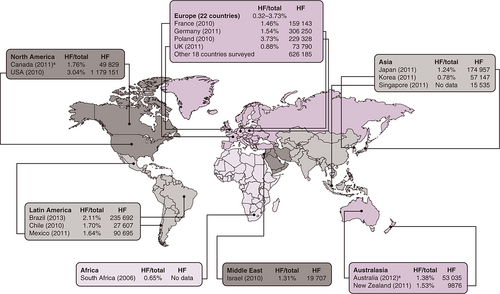
Caring for patients with heart failure comes at a high economic cost and accounts for about 1–3% of total healthcare expenditure in North America,69 Western Europe70 and Latin America.58 In comparison, the total global expenditure on all healthcare goods and services in 2010 was in the region of $6.5tn.71, 72 In Germany, the total medical costs attributable to heart failure were estimated at €2.9bn in 2006. This figure includes costs for inpatient, outpatient and day care services, as well as drugs, devices and other medical products.70 In the USA, the total hospital, physician, prescription and home healthcare costs associated with heart failure were estimated at $20.9bn in 2012 and are projected to rise to $53.1bn by 2030.45 The 2012 figure is comparable with the annual capital spend required to ensure clean, safe drinking water for the entire nation.73
The lengthy and repeated hospital stays that are typically required by patients with heart failure account for the majority of this economic burden.45, 70 Across the globe, the average length of hospital stay is about 5–10 days.3, 5, 6, 11, 12, 14, 19, 20, 24, 43 Over the past two decades, the length of stay has become shorter in Europe, North America and Australasia.3, 5, 11, 43 Nevertheless, in Europe and North America, about a quarter of patients admitted to a hospital with heart failure are readmitted within a month and up to two-thirds within a year, usually for recurrence of heart failure.11 Individuals who are readmitted with worsening or recurrent symptoms of heart failure are at a high risk of terminal decline.74 Hospital readmission can improve survival rates amongst patients with worsening heart failure; however, identifying those for whom long-term monitoring is a suitable alternative may be a more efficient use of resources (Section on Future Directions in Care: Urgent Unmet Needs).4
Patient perspective78
I'm not depressed… not really depressed… it's just a low feeling and it's not a happy feeling, and you just never feel your life's worth anything at times.
Caregiver perspectives79
At night, when he's lying in bed and I don't hear him breathe for a while, it gives me the nerves. Then I start counting. And suddenly I hear him breathing again. Then I think, oh dear, one morning I will wake up and then he's gone.
I don't mean to complain but if you are used to going out and now you have to stay home all the time, you know all the time. My daughter lives around the corner and I go out a lot with her, with the dog, to keep my mind off things…
I dare not stay away much longer. My daughter wants me to come along to go to the seaside and we will also take the dog with us, but I am afraid to go. To go out for a whole day is much too long.
Heart failure causes large numbers of deaths and widespread ill health and exacts huge economic and social costs—and the problem is becoming worse. Now is the time for coordinated public heart failure awareness programmes and strategic and political initiatives to improve care across the globe.
Preventing heart failure in high-risk groups
Preventing heart failure is of paramount importance. Once established, the deterioration in the heart's condition can often be treated but typically cannot be reversed. Policymakers should highlight the need for healthcare professionals across all clinical disciplines to identify patients with illnesses that increase the risk of heart failure and prescribe preventive medications. Equity of access to preventive medications should be provided for those at greatest risk of developing heart failure, regardless of age, sex or income. Policymakers should also prioritize the elimination of particular infectious diseases in parts of the world where they still cause heart failure.
What causes heart failure?
The term ‘heart failure’ describes a situation in which a person's heart cannot pump enough blood around the body but does nothing to explain why this condition arises. The clinical picture is complex because there are many possible causes of heart failure, and some are illnesses in their own right (Figure 5). Many cases of heart failure can be regarded as the end stage of other underlying illnesses and could be prevented if patients with these illnesses were identified and treated appropriately at an earlier stage.80
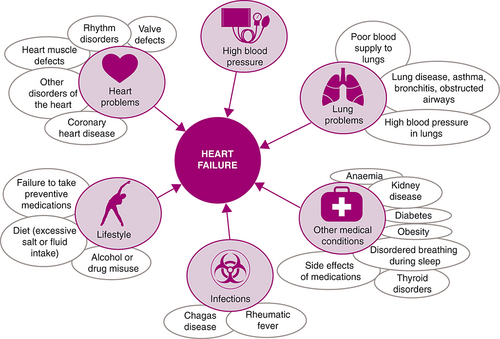
The heart is a remarkably adaptable organ. To cope with problems that increase the demands placed on it, the heart muscle is able to remodel itself to maintain output in the short term. However, if this remodelling continues in the long term, it can lead to abnormalities and eventually to heart failure. For example, pumping activity may decrease and valves may malfunction as the heart enlarges, dilates and stiffens. Sooner or later, these changes will manifest as overt symptoms of heart failure, unless the process of deterioration can be halted or delayed.
For most patients with heart failure, quality of life can be dramatically improved by therapies that relieve symptoms. For many patients, modern evidence-based medications or devices are available that slow or halt the progress of heart disease and improve survival. However, no therapies have been shown to prolong life for nearly half of all patients—those who have heart failure with preserved ejection fraction (HFPEF) (Section on Future Directions in Care: Urgent Unmet Needs).
How can heart failure be prevented?
The fact that treatment is not always effective in prolonging life means that prevention of heart failure should be prioritized by policymakers. This is particularly important for groups at high risk of developing this condition. Many people have existing illnesses that place them at risk of heart failure. Healthcare professionals treating such patients should adopt a broad approach that includes encouraging positive lifestyle changes that reduce the risk of heart failure (see Section on Improving Public Awareness of Heart Failure) and prescribing preventive therapies as appropriate. Medications that control blood pressure, heart rhythm and cholesterol levels are effective in preventing heart failure in the large number of people who have conditions such as high blood pressure, coronary heart disease, kidney disease and diabetes.81 Pacemakers and heart valve replacement can also prevent heart failure in the small number of people who have particular heart rhythm or valve disorders.82 The range of illnesses that predispose patients to heart failure is extremely wide. Healthcare professionals across all clinical disciplines should be educated to identify patients with illnesses that increase the risk of heart failure and prescribe preventive medications. This will ensure that as many people as possible benefit from available therapies.
Patients receiving long-term preventive therapies need to be assessed regularly at the cost of healthcare providers.81 In addition, those with chronic conditions, such as coronary artery disease or Chagas disease, should be evaluated periodically and monitored for changes to the heart. Patients with breast cancer are another group who would benefit from such monitoring. Several existing and new cancer treatments are toxic to the heart,83, 84 and it is important for healthcare professionals to be aware of the need to assess and manage the associated risks.85
Bacterial infections that cause heart disease have been largely eliminated in economically developed countries, owing to the use of antibiotics. In other regions, bacteria and tropical parasites cause a substantial proportion of heart failure cases, many of which could be prevented if appropriate therapies were used.86-88 The potential benefits of policy initiatives aimed at eliminating infectious diseases therefore extend to preventing heart failure in many parts of the world. In particular, continuing global efforts are warranted to eradicate Chagas disease, building on the progress that has been made in Latin America over the past two decades.89
Identifying and treating patients at risk of developing heart failure
Preventive treatment could be started earlier by identifying people with early signs of abnormal heart muscle remodelling. Large-scale screening programmes, such as those that have enabled earlier treatment for bowel, cervical and breast cancer, are unfortunately not possible because there is no simple diagnostic test for heart failure (see Section on The Need to Apply Best Practice).90 Early changes in the structure or function of the heart can be detected using medical imaging technology; it is not practical, however, to perform these complex procedures in the enormous number of individuals with illnesses that lead to heart failure and certainly not in the general population.90 In the future, advanced genetic tests and statistical modelling of at-risk groups may be available that consider the multitude of potential causes of heart failure, and these may allow specific individuals to be identified for in-depth screening (see Section on Future Directions in Care: Urgent Unmet Needs).82
Targeting preventive medications towards individuals at greatest risk of heart failure could increase cost-effectiveness, allowing more people to benefit. Further research in these areas is ongoing and should continue to be supported by public and private funds. In addition, awareness programmes should be aimed towards everyone with medical conditions that predispose to heart failure. These should include education about the symptoms of heart failure and the benefits of positive lifestyle changes. The same messages are important for public awareness programmes (see Section on Improving Public Awareness of Heart Failure).
Preventing heart failure in the elderly and socioeconomically disadvantaged: unique challenges
Preventing heart failure in the elderly is becoming a more pressing healthcare priority as populations age.91 Heart failure is the most common reason for hospital admission in people over 65 years of age in economically developed regions (see Section on The Global Burden of Heart Failure).3, 11, 92, 93 Elderly patients hospitalized with heart failure are mainly women.94 Although a number of studies of heart failure patients have indicated that survival rates are better in women than in men, recent research has shown that the long-term prospects for women are not as good as previously thought.95 Initiatives aimed at improving heart failure prevention should therefore include strategies for reaching out to older people, particularly older women.
In economically developed countries, heart failure is both more common and more likely to be the cause of death in people with low socioeconomic status than in the rest of the population.29, 96 This is still the case after adjusting for differences in age, medication use and the proportion of people with other heart-related diseases.96 It has been suggested that housing stability, social support, substance abuse, language proficiency and distance to hospital may play a role.97 More elderly women than men live alone and in poverty in the USA and often lack the social support of their families or communities. Social support can help people to seek medical attention if symptoms emerge and to change their lifestyles to reduce the risk of heart failure (Section on Improving Public Awareness of Heart Failure).98
In rapidly developing countries, governments face the double challenge of prioritizing the elimination of infectious diseases in resource-poor or rural settings whilst not neglecting the diseases emerging in urban areas as a result of a shift towards a Western-type lifestyle.57 That elderly, isolated, female or poor people are amongst those most likely to have heart failure has done little to raise the profile of the disease. It is time to improve awareness of heart failure via mass campaigns funded by governments and industry.
Improving public awareness of heart failure
Large numbers of premature deaths occur through ignorance of the causes and symptoms of heart failure. There is a pressing need for public awareness programmes that define heart failure in simple and accessible language, explain how to recognize the symptoms and emphasize the need for urgent medical attention. The other important messages are that most types of heart failure are preventable, and a healthy lifestyle can reduce risk. Policymakers should support the development and implementation of public awareness programmes focusing on these messages.
Public awareness of heart failure symptoms is dangerously low
Delaying hospital treatment by as little as 4–6 h after symptoms of heart failure appear can increase the chances of death,99-101 yet patients typically do not seek treatment for hours or even days after developing symptoms.102 Public education about the symptoms of heart failure and the need to contact a healthcare provider as soon as symptoms appear is essential to ensure that patients benefit fully from the available therapies and care.
Patient perspective2
I did at times start having queasy feelings and pains in my one side, and it happened once or twice when driving. I pulled off the road, but I didn't do anything about it. All of a sudden, I was developing sleep apnea or wasn't breathing right but sloughed it off until I could hardly breathe at all the last few days. I did ignore the original symptoms. The last day, I woke up and couldn't breathe well and told my kid to get me to the hospital. I was unconscious when I got to the hospital.
A healthy lifestyle reduces the risk of heart failure
Cost-effective awareness, education and support programmes to reduce the risk of heart failure should be at the forefront of public health directives.90 Lifestyle interventions could have substantial power to improve world health, because obesity, diabetes, cigarette smoking and high blood pressure all dramatically increase the likelihood of heart failure.90 In the USA alone, it has been estimated that a 30% reduction in the proportion of people classed as obese would prevent about 44 000 cases of heart failure every year, with an annual saving of nearly $500m in healthcare expenditure.106 Similarly, it has been estimated that a 5% reduction in the number of people with diabetes in the USA would prevent about 30 000 heart failure cases every year.107 Being severely overweight has been shown to double the risk of heart failure and smoking to increase it by about 50%.38
It is a sad fact that our improved understanding of these risk factors has not prevented an explosion in the numbers of people who are obese or who have diabetes or high blood pressure. Renewed commitment to public education about the importance of healthy diet and weight, regular exercise and avoiding smoking should be a priority for policymakers.
In low-income and middle-income countries, lifestyle-based interventions to prevent heart failure have been calculated to be more cost-effective than pharmaceutical interventions.108 The urgent need to address lifestyle risk factors globally is recognized by the United Nations,109 including in regions such as sub-Saharan Africa, where non-infectious diseases associated with a Western-type lifestyle are not yet the leading causes of death or illness.110 Given the already increasing numbers of patients with heart failure in economically developing regions, governments should be encouraged to combine lifestyle-based preventive measures with their programmes for tackling famine and pestilence.111 Regulating the aggressive marketing of high-calorie processed food by larger global corporate businesses, especially to school children and teenagers, could be considered.
The need to apply best practice
Compliance with clinical practice guidelines is often associated with improved outcomes for patients with heart failure. However, in many countries, there is considerable variation in how closely hospitals follow the national guideline recommendations for heart failure. In response, policymakers should champion equity of care for all patients. First, it is important to encourage heart failure education programmes that raise awareness of guidelines amongst all appropriate healthcare professionals. Second, improvements in care should be encouraged through the use of performance measures and incentives appropriate to the locality. Funding is needed for research into evidence-based healthcare performance measures that reflect improved clinical outcomes for patients with heart failure. By driving improvements in care, policymakers can provide a healthcare system that delivers timely access to diagnosis and treatment of heart failure, followed by a seamless transition to long-term management.
Guidelines worldwide agree on the key stages in heart failure care
Clinical practice guidelines aim to help healthcare professionals make evidence-based decisions about the care of individual patients. Guidelines have been published by many governmental and professional bodies across the globe (Figure 6).58, 63, 80, 112-124 Each of these aims to summarize and evaluate the available evidence for using particular medical interventions for particular patients. Guidelines may differ, though, in what evidence is included, how it is assessed and whether an intervention is considered appropriate for care in the relevant country or region.
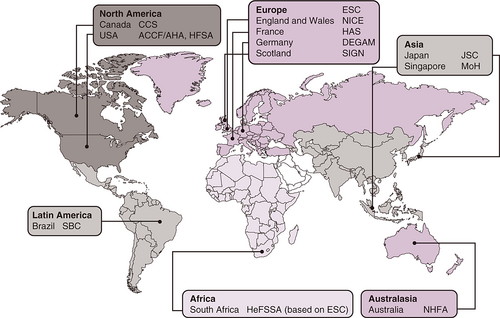
- Diagnosis should be timely and accurate.
- Treatment should be appropriate to each patient and available urgently, if necessary.
- Long-term management should include follow-up, monitoring and support.
Smooth transitions between these stages are also crucial for ensuring that patients with heart failure are managed optimally throughout their healthcare journey. Depending on the severity of their symptoms and the services and facilities available in their communities, patients can follow many different and complex pathways through healthcare systems (Figure 7).11 Best practice involves a seamless system of care that embraces both hospital and community.
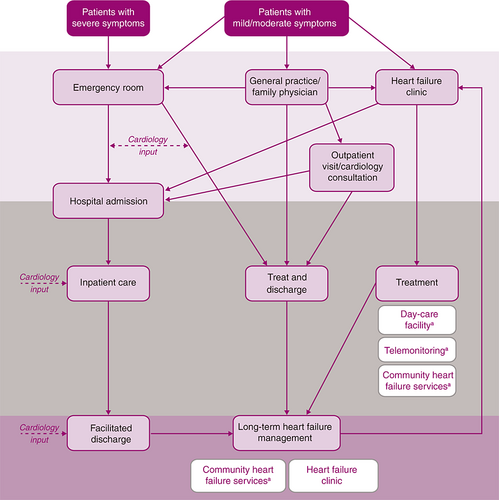
International consensus recommendations could help to identify the best ways to improve practice in diagnosis, treatment and long-term management. For example, although the published guidelines agree on which diagnostic tools are useful, they disagree on which should be used for all patients with suspected heart failure and in what order.125 A consensus recommendation leading to greater clarity about best practice should be encouraged, with endorsements from credible local bodies.
Best practice in heart failure care involves compliance with guidelines
Survival rates increase and readmission rates fall when patients with heart failure are cared for in hospitals that comply with clinical practice guidelines.126-128 Nevertheless, considerable variation in the quality of heart failure care and clinical outcomes between different hospitals has been demonstrated in several countries.46, 129-132 Before discussing ways of encouraging compliance with guidelines, this section presents evidence to show that there is room for improvement at all three stages of heart failure care.
Best practice in diagnosis requires appropriate facilities and knowledge
Diagnosing heart failure can be challenging, even for trained professionals. Not all patients with heart failure have the typical symptoms, and the same symptoms can be experienced by patients who do not have heart failure. Making an accurate diagnosis requires a range of diagnostic tools and information, in conjunction with clinical judgement and expert knowledge (Figure 8).
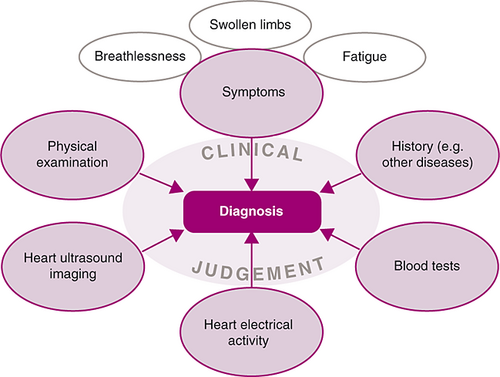
Not all hospitals and care centres have a full range of diagnostic tools available, especially in resource-poor settings.111 Furthermore, even when facilities are available, they are not always used. For example, all published guidelines agree that diagnosis should involve ultrasound imaging to assess heart function, but 10–25% of patients admitted to hospital with a primary diagnosis of heart failure in Europe and the USA do not undergo ultrasonography.133
Many patients are not initially seen by an expert in heart failure because of where they enter the healthcare system. Those with severe symptoms, such as breathlessness at rest, are most often assessed by paramedics or emergency doctors in hospital, whereas those with less obviously life-threatening symptoms are likely to go to their family doctor or an outpatient clinic (Figure 7). Education programmes are needed to raise awareness of clinical practice guidelines amongst healthcare professionals from a wide range of specialties who may be the first to encounter patients with undiagnosed heart failure.
All suitable patients should receive recommended evidence-based therapies
All published guidelines recommend the use of modern evidence-based medications and devices that have been shown to benefit patients with heart failure. For example, there are medications that have been shown to improve survival in patients who have left ventricular systolic dysfunction (LVSD).80 LVSD is weak pumping activity in the compartment of the heart that supplies blood to the body; it occurs in about half of patients with heart failure. In patients with heart rhythm problems, and in some patients with LVSD, implanted devices that continuously monitor the activity of the heart and automatically deliver the right type of electrical stimulation can dramatically improve survival.80
Despite clear recommendations regarding evidence-based medications, many patients with heart failure do not receive a prescription for potentially beneficial medication, because prescribers do not always comply with the guidelines. In a survey of hospital discharges in the USA, more than a quarter of patients with heart failure who should have been given appropriate medication did not receive a prescription.127 In Europe, prescription rates for recommended medications are also low, and when they are prescribed, the doses specified are often below those recommended.128, 134 In Africa, the available information indicates that fewer than half of patients admitted to hospital with heart failure receive preventive medications, and a specific combination of drugs shown to be effective in African Americans is seldom used.5 There is scope for policymakers to incentivize improved prescribing of evidence-based medications to suitable patients.
Guideline recommendations for heart failure medications are based on evidence from clinical trials conducted mainly in Europe and the USA.80 In other parts of the world, the underlying causes of heart failure vary, and it is not safe to assume that medications will be equally effective in all patient populations. Further clinical research to investigate the effectiveness of heart failure medications in different groups of patients across the world should be supported.135
Long-term patient management is as important as diagnosis and treatment
Diagnosis and initial treatment mark only the start of the healthcare journey for a patient with heart failure. Guidelines recommend a seamless transition to a management programme for long-term care that incorporates follow-up, monitoring and support. However, surveys have reported that most hospitals in the USA had fewer than half of 10 key recommended practices in place and fewer than 3% had all 10 in place.136 In Europe, only 7 of 26 countries reported having heart failure management programmes in more than 30% of their hospitals.137 Even when in place, such programmes are not always used.138 As well as hospitals, community heart failure clinics and specialist nursing services have important roles to play in the long-term management of patients (see Section on Future Directions in Care: Urgent Unmet Needs). Uptake of recommended management practices should be encouraged alongside initiatives to improve diagnosis and treatment of patients with heart failure.
Encouraging compliance: measuring and improving quality of care
Measuring performance and incentivizing improvement are key parts of bringing patient care into line with guidelines. Policymakers need to be aware, however, that not all performance measures currently in use necessarily reflect improved clinical outcomes for patients with heart failure.139 As well as recording survival and rehospitalization rates of patients with heart failure, an ideal measure would also capture how efficiently resources are used.11 Performance measures should be tailored to reflect local circumstances, particularly in low-income and middle-income countries where it would be unrealistic to offer every potentially beneficial therapy.140
Audits, registries and professional initiatives
Audits enable quality of care and outcomes for patients to be compared, so that informed, evidence-based improvements can be made. For example, the UK's annual National Heart Failure Audit collects information about every adult hospitalized with heart failure in England and Wales. Examples of success include a hospital that improved its heart failure inpatient survival rates from 77% (below average) to above average (94%) by introducing a specialist heart failure team. Another hospital improved survival of inpatients with heart failure (from 87% to 92%) and reduced 30 day readmission rates (from 24% to 15%) by increasing compliance with several guideline recommendations for diagnosis, treatment and long-term management.46
Registries are the main source of real-world data on severity, causes, treatment, long-term management and outcomes for patients hospitalized with heart failure. They are less comprehensive than audits, because they do not attempt to include every patient. Although the majority of registries are set up only to collect data, it has been suggested that the feedback provided by the benchmarked reports produced by some registries can lead to improvements in guideline adherence. For example, both the use and the prescription at discharge of drugs that control heart rate increased by about 30% over the 3 years that data were submitted to the first major registry of patients with heart failure (the ADHERE registry in the USA).39
To date, most data collected in registries is from North America or Western Europe; however, the underlying causes of heart failure are different in other parts of the world. Heart failure registries therefore need to be set up in more regions to improve global understanding of how heart failure develops and how it can be prevented. Country-level registries such as HEARTS in Saudi Arabia (the first in an Arab population)24 and CHART-2 in Japan141 have already contributed to the overall picture, and the major multi-national GULF CARE and ASIAN-HF registries have now been established in the Middle East and Asia, respectively. Each of these multi-country databases is set to contain information on approximately 5000 patients, and results of the first analyses from the GULF CARE survey are expected shortly.
Professional initiatives can offer advice and support for improving compliance with guidelines. For example, in the USA, hospitals can join the ‘Get with the Guidelines—Heart Failure’ programme run by the American Heart Association. Hospitals sign up to use a performance improvement tool that records data and assists with decision-making, and good performers receive public recognition. A survey of hospitals taking part in the programme showed that improved discharge and transitional care processes reduced 30 day readmission rates for patients with heart failure, although other strategies examined in the survey were not associated with improved patient outcomes.142
Financial incentives and penalties
Improvements in hospital performance can be encouraged by imposing financial penalties or offering financial rewards (known as ‘pay-for-performance’). For example, hospitals in the USA have been obliged since 2001 to report on performance measures related to heart failure care,143 and the Medicare budget of a hospital can be reduced if standards are not met. Many countries impose penalties on hospitals for all readmissions within 30 days of discharge. These penalties are designed to reduce preventable readmissions, but there is concern that they may unfairly punish hospitals with good survival rates and that they may in fact reflect variations in standards of community care after discharge rather than care in a hospital.144 Incentives for good performance can also be offered outside of hospitals. For example, in the UK, primary care physicians can sign up to the Quality and Outcomes Framework,145 which includes heart failure indicators, targets and payment points.146
Care pathways
Compliance can be encouraged through the use of care pathways, which are guideline-based systematic plans for the care of particular patients over a specific time period. Care pathways have been shown to improve survival amongst hospital patients with heart failure, but there is no ‘one size fits all’ pathway suitable for use in all healthcare organizations.147 Acute heart failure care ‘bundles’ are being adopted in Scotland. These short checklists focus on improving diagnosis (via expert review), improving treatment (via evidence-based prescription) and improving long-term management (via referral to a heart failure nurse service); initial results show promise in improving survival rates.148
What are the implications for policymakers?
I'mproving the performance of healthcare services by providing incentives and management systems that encourage compliance with guidelines is a powerful tool for policymakers. It is not necessarily safe to assume, however, that patients with heart failure will enjoy longer life and a reduced chance of hospital readmission as a result of even nominally successful performance improvement programmes. Just as medications and devices have to be tested in clinical trials to show that they are effective and safe, it has been argued that management strategies should also be supported by robust scientific evidence before they are mandated by organizations that pay for healthcare.149
Policymakers should fund and encourage activities that build an evidence base for driving improved care and outcomes for patients with heart failure. There is a pressing need for research into evidence-based healthcare performance measures that reflect improved clinical outcomes for patients with heart failure. In parallel, more widespread data collection via audits or registries should be implemented where country-level initiatives are not already in place.
Future directions in care: urgent unmet needs
There are urgent unmet needs at all stages of heart failure care (Figure 9).
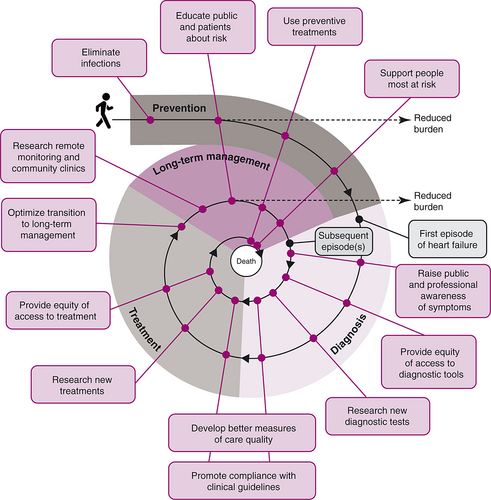
In addition to the policy measures discussed in previous sections, it is crucial to support international collaborative research into the causes, diagnosis, treatment and long-term management of heart failure across the globe. In economically developing nations, there is both a desperate need and a growing market for affordable therapies. Industry should be encouraged to take up this opportunity. Policymakers can also make a substantial difference by encouraging seamless transitions to long-term management. Resources should be provided for the education and practical support of patients with heart failure and their families or other caregivers, empowering them to engage proactively in managing long-term care.
Diagnosis: improved tools for medical decision-making in heart failure
Blood tests exist that are useful for ruling out a diagnosis of heart failure, but they cannot positively identify patients who do have heart failure.80 Diagnosis therefore remains complex and relies on the clinical judgement of an experienced healthcare professional (Section on The Need to Apply Best Practice). A new specific and sensitive blood test could make diagnosis of heart failure quicker, easier and more accurate. A suitable blood test could also enable large numbers of people to be screened for early signs of heart failure (Section on Preventing Heart Failure in High-risk Groups). Continued support is warranted for basic scientific research aimed at discovering the molecular signatures in the blood of different types of heart failure.
In the future, statistical methods known as risk stratification could be used to identify patients who need treatment most urgently.150 Patients have a high risk of dying from heart failure if they are admitted to hospital with very high or very low blood pressure, low blood oxygen levels, poor kidney function or a history of coronary heart disease. However, assessing any of these parameters in isolation is not accurate enough to drive decisions about a patient's care. Risk stratification involves entering several parameters into a statistical model to generate a profile of the treatment and follow-up most suitable for an individual patient. This has the potential to improve efficiency by enabling high-risk patients to be identified for intensive treatment in hospital, whilst others are safely discharged or treated as outpatients.150 Further development of risk stratification methods to make them suitable for widespread adoption should be supported.
Treatment: new options are needed for many patients with heart failure
Although symptoms can usually be relieved, modern heart failure therapies do not prolong life in about half of all patients. New therapies are needed for patients who have HFPEF (refer to the succeeding texts for a description), acute heart failure, advanced heart failure and certain heart muscle disorders. This highlights the need for policymakers to encourage international collaborative research to improve the understanding of how heart failure develops and how it can be prevented. Additionally, more affordable therapies are required for the huge market in the economically developing world.
Heart failure with preserved ejection fraction
Nearly half of patients with heart failure have a form of disease known as HFPEF. Although symptoms can be controlled, no treatment has yet been shown to improve survival in patients with HFPEF, and death rates have remained unchanged over the past 20 years.151 Unlike most patients, those with HFPEF have no obvious reduction in the proportion of blood pumped out of the chamber of the heart that supplies blood to the body (the ejection fraction),33 and many of them are elderly women with a history of high blood pressure.34 HFPEF is a general term used to describe patients who probably have a variety of underlying diseases, despite all having similar symptoms. This has made it particularly difficult to find effective therapies to treat HFPEF and highlights the need for more basic research into its causes.151 Governments and industry should continue to support the testing of existing medications in large-scale clinical trials and the development of new drugs for the treatment of HFPEF.
Acute heart failure
Patients with acute heart failure experience a rapid worsening of symptoms, which often leads to emergency hospitalization. Therapies for acute heart failure have generally changed little over the past two decades, despite ongoing research.11 Options are limited to drugs that relieve breathlessness and reduce fluid build-up by increasing urine production or dilating blood vessels. Drugs that act directly on the heart muscle to increase the force of contractions can have adverse effects and are used only in critically ill patients when the oxygen supply to vital organs is dangerously low. None of these medications does anything to address the underlying cause or causes of heart failure, leaving patients at a high risk of death after discharge from a hospital.152 Despite the difficulties of conducting clinical research in an emergency setting, governments and industry should continue to support development of new medicines for treating acute heart failure.
Advanced heart failure
As a weakening heart tries to maintain its function, the adaptive remodelling changes in the heart muscle initially maintain heart output but eventually lead to a vicious cycle of worsening heart failure as the heart becomes more and more abnormal. Patients in this debilitating stage of the disease are usually repeatedly hospitalized for recurrent episodes of acute heart failure, any one of which could result in death. For patients with worsening HFPEF, nothing can currently be performed to slow their decline.
In the past, clinical trials have focused on treating heart failure either during a single hospital admission or outside a hospital. The unique features of patients with advanced heart failure mean that clinical trials need to extend beyond a single hospital admission. Encouraging such research would provide evidence to support the use of current and new therapeutic options in this group of extremely vulnerable patients.153, 154
Patients who have heart failure and other diseases
Many patients with heart failure also have other medical conditions, such as kidney disease, lung disease or diabetes. These illnesses are particularly common in individuals with heart failure who are elderly or have been hospitalized.155 Many heart failure medications may not be suitable for patients who also have other medical conditions. This is because the drugs used to treat different diseases may interfere with one another, or a drug suitable for treating one disease may worsen the other.80 New therapies are usually tested in young patients who have only heart failure, but they may not have been shown to work in the real world, where many patients have several overlapping diseases.133 This underscores the need to support basic clinical research into the underlying diseases that lead to heart failure so that new therapies can be tested in specific groups of patients most likely to benefit.
Heart failure during and after pregnancy
Worldwide, an increasing number of women are recognized as having heart problems when they become pregnant. Symptoms of heart failure can appear during the last month of pregnancy or within a few weeks of giving birth. There is a need to build an evidence base to support recommendations about how to prevent and treat this complex condition, especially in economically developing countries.156
Overlooked heart muscle disorders
Some patients in Africa have specific types of irreversible heart muscle disease that are not known to occur elsewhere and are very poorly understood.157 Heart muscle disorders that are uncommon in the rest of the world have also been identified in Japan.57 Furthermore, there is no evidence base for treating heart failure caused by Chagas disease, and the causes of Davies disease are still not understood. The scope of heart failure research therefore needs to extend beyond the causes of disease that are common in Western countries.
Affordable heart failure therapies
The costs of caring for an individual patient with heart failure have increased substantially over the past three decades as new therapies have been proved to be effective. However, it is unrealistic for healthcare systems in all parts of the world to offer every potentially beneficial evidence-based therapy.140 As well as ensuring that resources are used efficiently and cost-effectively, policymakers should fund research into more affordable therapies and medical devices for the huge market in the economically developing world.
Long-term management: innovation could save lives and money
In most patients, heart failure is a long-term disease that involves one or more episodes of hospitalization. New strategies for long-term monitoring and management of patients outside a hospital may improve quality of life and survival rates while reducing the number and frequency of readmissions.
New approaches to long-term management outside a hospital
Remote monitoring could help to identify life-threatening deterioration that requires patients to return to a hospital rapidly. It could also allow individuals to leave hospital earlier than at present, without placing them at extra risk.158 Technologies being tested include telemonitoring devices (some of which are surgically implanted) and telephone support (either automated or person to person).159 Despite the promise of these approaches, it is not yet clear whether they improve survival.160 Policymakers should encourage more research before recommending telemonitoring.
Care by specialist clinics or teams after discharge from hospital has been shown to increase survival rates amongst patients and to deliver cost savings by reducing hospital readmissions.161, 162 Community clinics specializing in heart failure can provide patients with access to teams of healthcare professionals and up-to-date diagnostic facilities and therapies outside hospital. Specialist nurses are key members of such teams and are instrumental in delivering long-term care.163 It is not the location but the quality of care that produces results, and healthcare providers should be aware that new community clinics are most likely to benefit patients when they complement existing hospital services.
Palliative care services aim to improve quality of life for patients and their families through a holistic approach that addresses psychological, social and spiritual needs. This type of approach can play an important role in facilitating emotionally difficult discussions between patients and healthcare professionals. However, at present only a minority of patients with heart failure are referred to palliative care services.164 Incorporating palliative care into management pathways could aid decision-making by improving communication between healthcare professionals, patients and their families.11
The importance of encouraging patient self-care
Any programme aimed at improving long-term management should recognize that patients with heart failure have a key role to play in their own care. Self-care comprises maintenance, monitoring and management (Figure 10). Maintenance involves taking medication as prescribed, exercising regularly and eating a healthy diet. Monitoring involves keeping watch on symptoms and weight (which can provide a warning sign of increasing fluid accumulation). Management involves responding to changes in symptoms, by adjusting doses of certain medications if they have been prescribed for ‘use as needed’ (e.g. drugs that increase urine production to reduce fluid accumulation), or by seeking medical attention if symptoms worsen.165
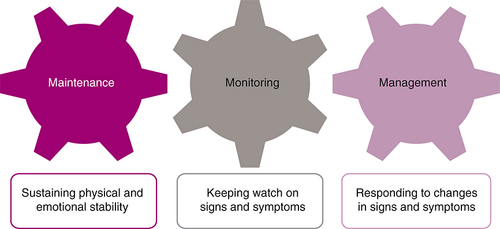
A worldwide survey has revealed the need to improve patient self-care. Most patients reported taking their medication as prescribed but few reported monitoring their weight or taking exercise regularly.166 Education programmes are a priority but need to be designed carefully because patients with greater knowledge of heart failure have been reported to be more likely to delay seeking treatment.167 This may reflect false optimism and a lack of understanding that controlling the symptoms of heart failure does not slow the progression of the disease. The education medium also needs to be considered carefully. Short video clips, text messages and social media could be used to deliver simple but accurate messages. With 6 billion people now estimated to own a mobile phone,168 technology may provide an important way of reaching the remote and socioeconomically disadvantaged.
Educating people about how to support a partner, family member or friend with heart failure is also an important part of promoting self-care. Patients are more likely to engage in beneficial self-care behaviours if they have someone to help them than if they are socially isolated. This emphasizes the need to improve community support for socioeconomically disadvantaged patients and those who live alone.169 Policymakers should provide resources for the education and support of individuals with heart failure and their caregivers, empowering them to engage proactively in managing long-term care.
Acknowledgment
Support for the writing and editing of this publication was provided by Oxford PharmaGenesis™ Ltd, UK, with funding from the Heart Failure Association of the European Society of Cardiology. The Global Heart Failure Awareness Programme is supported by Novartis Pharma AG and SERVIER, in the form of an unrestricted educational grant.
Conflict of interest
None declared




